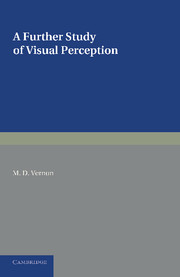Book contents
- Frontmatter
- Contents
- List of Illustrations
- Acknowledgements
- Chapter I INTRODUCTION
- Chapter II THE NATURE OF PERCEPTION
- Chapter III THE PERCEPTUAL PROCESS
- Chapter IV THE DETERMINATION OF FORM
- Chapter V SPATIAL PERCEPTION
- Chapter VI THE CONSTANCIES
- Chapter VII THE FUNCTIONS OF THE FRAMEWORK IN PSYCHO-PHYSICAL EXPERIMENTS
- Chapter VIII THE PERCEPTION OF MOVEMENT
- Chapter IX MICHOTTE'S STUDIES OF SOME INTRINSIC PHENOMENA OF EXPERIENCE
- Chapter X THE INFLUENCE OF INTERNAL AND INDIVIDUAL FACTORS UPON PERCEPTION
- Chapter XI CONCLUSION
- Appendix A
- Appendix B
- References
- Index of Authors
- Index of Subjects
Chapter IV - THE DETERMINATION OF FORM
Published online by Cambridge University Press: 05 June 2016
- Frontmatter
- Contents
- List of Illustrations
- Acknowledgements
- Chapter I INTRODUCTION
- Chapter II THE NATURE OF PERCEPTION
- Chapter III THE PERCEPTUAL PROCESS
- Chapter IV THE DETERMINATION OF FORM
- Chapter V SPATIAL PERCEPTION
- Chapter VI THE CONSTANCIES
- Chapter VII THE FUNCTIONS OF THE FRAMEWORK IN PSYCHO-PHYSICAL EXPERIMENTS
- Chapter VIII THE PERCEPTION OF MOVEMENT
- Chapter IX MICHOTTE'S STUDIES OF SOME INTRINSIC PHENOMENA OF EXPERIENCE
- Chapter X THE INFLUENCE OF INTERNAL AND INDIVIDUAL FACTORS UPON PERCEPTION
- Chapter XI CONCLUSION
- Appendix A
- Appendix B
- References
- Index of Authors
- Index of Subjects
Summary
THE PHYSICAL PROPERTIES OF THE STIMULUS AND THE PERCEIVED FORM
We have dealt at some length with the characteristics of the process which occurs when a real object or its representation are perceived. We showed that there was a combination and integration of sensory data, and their assimilation to some category of experience which determined the ‘meaning’ of the percept as an object or representation, and hence the name given to it. In this process many details of the sensory data were ignored or modified. But in addition to these modifications are others which seem to characterize the perception of form or shape as such. This is by no means entirely determined by the exact sensory properties of the retinal image—the distribution in it of light, shade, and colour. Not only do the perceived qualities of form differ from those of the stimulus pattern and the retinal image; but also they appear to be modified in accordance with certain general principles. These have been formulated and studied experimentally by the Gestalt psychologists. But before their extensive work is considered, it is desirable to study first the work of other psychologists on the ‘formal’ qualities of visual perception, and their relationship to the sensory stimulus pattern.
The phenomenal percept, then, is never an accurate photographic reproduction of the external stimulus field. This is not to deny that the percept varies as a rule when the physical qualities of the stimulus vary, but that it does so proportionately; there is no ‘constancy’ of relationship between the variables. Even with the extreme simplification of experimental conditions which is employed in psychophysical experiments, the determinations obtained are at best approximations. Weber's Law even within narrow limits is never a completely accurate statement of events. The ‘sensatioriists’ wouldposit that if the experimental conditions are sufficiently controlled and simplified, the only errors and inaccuracies of response are those produced by the chance factors which introduce variability into the most accurate physical measurements, the so-called ‘personal equation’. Their opponents point out that not only has such a state of perfection never been reached, but that it never could be attained without creating in the observer a special type of response, which depends as much upon the observer's training and attitude as upon the physical stimulus. We shall discuss these attitudes in detail in Chapter x.
- Type
- Chapter
- Information
- A Further Study of Visual Perception , pp. 46 - 80Publisher: Cambridge University PressPrint publication year: 2013



